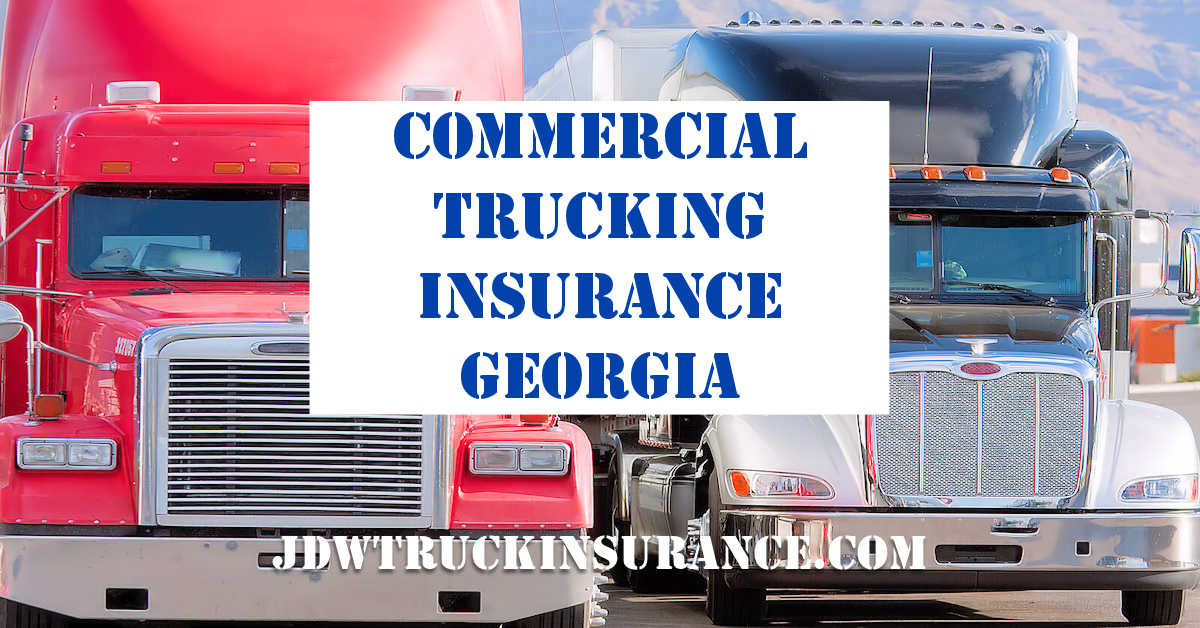Owner Operator Trucking Insurance St. Marys, Georgia
New Authority Truck Insurance Georgia
Commercial truck insurance Georgia. Owner Operator Trucking Insurance St. Marys, Georgia. Affordable commercial truck insurance GA. Top rated commercial truck insurance companies Georgia.
Owner Operator Trucking Insurance St. Marys, Georgia
If you are searching for New Authority Truck Insurance Georgia. JDW Truckers Insurance specializes in New Authority Truck Insurance in Georgia. We help you get affordable commercial insurance rates for your new authority.
We offer quote from only the top rated commercial truck insurance companies who offer the best rates for your new authority in Georgia.
JDW will help get the the correct commercial truck insurance in place which will fit your budget and allow you to haul the cargo you want and need to in order to be successful.
We are here to answer your questions with fast and friendly service.
Owner Operator Trucking Insurance St. Marys, Georgia
We offer affordable new authority trucking insurance for the entire state of Georgia.
We Customize your New Authority Truck Insurance to Help you Save Money!
Our agents at JDW Truckers Insurance know trucking insurance in Georgia. We will explain the different options and commercial truck insurance requirements in Georgia.
We help you get the right coverages in place so you are no over paying for coverages you may not need. We also help you make sure you have the coverages you need in place. And we do this at affordable commercial truck insurance rates.
New Authority Truck Insurance Requirements and Options
General Liability Insurance for Truckers
- General liability insurance for truckers should not be confused with primary liability for truckers.
- Similar to primary liability. General liability offers coverages to pay for physical damage to other and/or bodily injury to others. BUT there is a difference between the two.
- For example, if you are loading or unloading and you cause injury to someone or their property this is when the general liability policy would respond.
- The actions of a driver while representing the insured and on the premises of others, such as loading docks and truck stops
- General Liability is normally offered $1,000,00 per occurrence and $2,000,00 aggregate. What does this mean?
- It the insurance company will pay up to $1,000,000 for any one claim and no more than $2,000,000 per year for the total of all claims.
- General liability can be required by shippers and other companies such as the UIIA and flatbed operations.
- If there is any chance you might be involved in loading or unloading. General Liability is relatively inexpensive and is an advised coverage.
Auto Liability Insurance
- Your Auto Liability or primary liability will be the major cost for your trucking insurance policy. Although the FMCAS can only require $750,000 in most cases shippers will require $1,000,000 in primary liability insurance coverage before they will allow you to pick up loads.
- Primary liability insurance covers damages to third parties for bodily injury and physical damage to others property in the event of an accident.
Medical Pay
- In most cases this is a low cost add on to your primary liability insurance to cover medical expenses.
PIP – Personal Injury Protection
- Some states require this coverage and, in many cases, can reduce the need for Medical Pay.
- Personal injury protection (PIP), also known as no-fault insurance, covers medical expenses and lost wages of you and your passengers if you’re injured in an accident. PIP coverage protects you regardless of who is at fault.
Uninsured Motorist
- If you’re hit by a driver with no insurance…
- Uninsured motorist bodily injury (UMBI) may pay medical bills for both you and your passengers.
- Uninsured motorist property damage (UMPD) may pay for damage to your vehicle.
Underinsured Motorist
- If you’re hit by a driver with not enough insurance…
- Underinsured motorist bodily injury (UIMBI) may pay medical bills for both you and your passengers
- Underinsured motorist property damage (UIMPD) may pay for damage to your vehicle
Motor Truck Cargo
- MTC or Cargo insurance provides insurance on the freight or commodity hauled by a for-hire trucker. It covers your liability for cargo that is lost or damaged due to causes like fire, collision or striking of a load.
- If your load is accidentally dumped on a roadway or waterway, some cargo forms offer Removal Expenses coverage pays for removing debris or extracting pollutants caused by the debris. And can also pay for costs related to preventing further loss to damaged cargo through Sue and Labor Coverage and legal expenses in the defense or settlement of claims. Another option is Earned Freight Coverage to cover freight charges the customer loses because of an undelivered load.
- Cargo insurance deductibles can be set at $1,000, $2,500, $5,00 or even higher if you are self-insured.
- Cargo coverage limits are normally set at $100,00 but some shippers may have higher requirements depending on the cargo you are hauling.
- Cargo policies can have exclusions stating what cargo it will or will not cover.
Trucking Physical Damage Insurance (PD)
- Physical damage insurance coverages are designed to pay for losses to your equipment and damages to others equipment. (Others equipment must be listed on your policy).
- If you own or lease equipment. You may be required to have PD by bank or leasing company to carry a set amount of physical damage insurance and name them as a Loss Payee.
- PD can also cover damage to others equipment you are in possession of if the coverage is listed on your policy. An example would be non-owned trailer insurance coverage.
- Deductibles for physical damage range from $1,000 to $5,000.
- Required deductibles. If you have a loan on your equipment or it is leased. They bank or leasing company may have a minimum deductible you can have on your physical damage policy.
Owner Operator Trucking Insurance St. Marys, Georgia
Chat with JDW Truckers Insurance. We are fast and friendly. Great customer service. Free 24/7 COI.
We offer affordable new authority truck insurance in:
AL – AR – FL – GA – IN – MO – MS – NC – OH – PA – SC – TN – TX – VA
We offer new authority truck insurance quotes for:
- Dry van
- Flatbed
- UIIA
- Amazon
- Reefer and more
Owner Operator Trucking Insurance St. Marys, Georgia
Owner Operator Trucking Insurance St. Marys, Georgia
St. Marys is a city in Camden County, Georgia, United States, located on the southern border of Camden County on the St. Marys River in the state’s Low Country. The Florida border is just to the south across the river, Cumberland Island National Seashore is to the northeast, and Kingsland, Georgia, is to the west. Jacksonville, Florida, is 38 miles south, and Savannah, Georgia, is 110 miles north.
The city is home to the National Seashore’s visitor center and boat access; the St. Marys Submarine Museum, and Crooked River State Park. It is bordered by Kings Bay Naval Submarine Base, home port for several Ohio-class submarines. The city hosts the annual St. Marys Rock Shrimp Festival.
The area was first explored in the mid-16th century by Spanish expeditions as part of the settlement of Spanish Florida. Through the decades it also came under the colonial influence of Great Britain and finally the United States. By the 2020 census, the city had a population of 18,256.
St. Marys is located along the southern border of Camden County on the north bank of the St. Marys River. The state of Florida is to the south, across the river. The city of Kingsland borders St. Marys to the west.
According to the United States Census Bureau, St. Marys has a total area of 24.9 square miles (64.5 km), of which 22.5 square miles (58.3 km2) is land and 2.4 square miles (6.2 km), or 9.57%, is water.
St. Marys has a humid subtropical climate (Cfa) with long, hot summers and short, mild winters.
The St. Marys river area was first explored by Spanish expeditions in the mid 16th century as part of the settlement of Spanish Florida, with nearby St. Augustine as the established capital. The original Spanish settlement was founded in 1566, making this the second-oldest continuously inhabited European-established settlement in the what became contiguous United States. Settlement for colonial Georgians became legal after the Treaty of Paris in 1763, when Britain exchanged some territory with Spain after defeating France in the Seven Years War.
Following independence in the American Revolutionary War, local inhabitants of Camden County gathered on Cumberland Island and signed a charter for “a town on the St. Marys” on November 20, 1787. There were twenty charter members, who each received four town lots and one marsh lot (outside the boundary of the town on the east side in the marshes); each lot was 4 acres (1.6 ha) square, with the total town area being 2,041 acres (826 ha). These twenty city founders are named on an historical marker in downtown St. Marys: Isaac Wheeler, William Norris, Nathaniel Ashley, William Ashley, Lodowick Ashley, James Seagrove, James Finley, John Fleming, Robert Seagrove, Henry Osborne, Thomas Norris, Jacob Weed, John Alexander, Langley Bryant, Jonathan Bartlett, Stephen Conyers, William Keady, Prentis Gallup, Simeon Dillingham and Richard Cole.
The original boundaries of the town correspond to the modern waterfront, Bartlett Street, North Street, and a block east of Norris Street. There were two public town squares. However, in the original deed the town was unnamed, and for several years afterwards in public documents it was referred to as either St. Marys or St. Patrick’s, and colloquially as simply “the New Town”. Accounts differ regarding the origin of the name—some say it is named after the St. Marys River, while others say it comes from a seventeenth-century Spanish mission, Santa Maria, on nearby Amelia Island, Florida. St. Marys was recognized by an act of the Georgia legislature on December 5, 1792, with the result of incorporation in November 1802.
Oak Grove Cemetery is included in the St. Marys Historic District and was laid outside the western border of St. Marys during its founding in 1787.
On June 29, 1796, the Treaty of Colerain was signed just up the river from St Marys between the United States and the Creek Nation, the indigenous inhabitants of this territory. St. Marys town founder Langley Bryant served as the official interpreter between the Creek Indians and the United States.
St. Marys was made a United States port of entry by act of the U.S. Congress March 2, 1799. The first Collector was James Seagrove. During the antebellum period, Archibald Clark served as the U.S. Customs Collector from 1807 until his death in 1848.
After the Act Prohibiting Importation of Slaves took effect in 1808, St. Marys became, along with Spanish Amelia Island, a center for smuggling, especially during the period between 1812-1819 when various rebel groups held Amelia Island.
During the War of 1812 the Battle of Fort Peter occurred near the town, at the fort on Point Peter along the St. Marys River. The British captured the fort and the town and occupied it for about a month.
The United States Navy bombarded the town’s shoreside buildings during the American Civil War.
St. Marys served as Camden County’s seat of government from 1869 until 1923.
As of the 2020 United States census, there were 18,256 people, 6,966 households, and 4,998 families residing in the city.
As of the census of 2000, there were 13,761 people, 4,837 households, and 3,758 families residing in the city. The population density was 733.8 inhabitants per square mile (283.3/km2). There were 5,351 housing units at an average density of 285.3 per square mile (110.2/km). The racial makeup of the city was 72.78% White, 19.99% African American, 0.47% Native American, 1.21% Asian, 0.07% Pacific Islander, 1.56% from other races, and 2.09% from two or more races. Hispanic or Latino people of any race were 4.46% of the population.
There were 4,837 households, out of which 47.8% had children under the age of 18 living with them, 59.8% were married couples living together, 14.2% had a female householder with no husband present, and 22.3% were non-families. 16.8% of all households were made up of individuals, and 2.9% had someone living alone who was 65 years of age or older. The average household size was 2.83 and the average family size was 3.18.
In the city has a population with 33.4% under the age of 18, 11.2% from 18 to 24, 34.7% from 25 to 44, 15.6% from 45 to 64, and 5.2% who were 65 years of age or older. The median age was 28 years. For every 100 females, there were 97.8 males. For every 100 females age 18 and over, there were 95.3 males.
The median income for a household in the city was $42,087, and the median income for a family was $46,065. Males had a median income of $35,419 versus $24,449 for females. The per capita income for the city was $18,099. About 9.6% of families and 11.2% of the population were below the poverty line, including 14.5% of those under age 18 and 7.1% of those age 65 or over.
Media related to St. Marys, Georgia at Wikimedia Commons
Choose the Right Agent
When choosing the agent, you want to represent you to the insurance companies. Pick an agent that is trained in commercial truck insurance. And make sure the agent you choose to work with is there when you need them. Our agents are trained in commercial truck insurance and are easy to contact. Email, phone call or text message. We respond quickly to our clients.
Certificate of Insurance
Not being able to get a quick COI could cost you money by not being able to pick up a load for the lack of a COI. Our clients at JDW Truckers Insurance are given access to our COI Portal where they can issue a COI 24/7 free of charge.
Insurance Companies Customer Service
Not only should you choose a responsive agent but you will want to be insured by a commercial insurance company who also responds to your requests and are there to help you in case of a claim or endorsements
AM Best Ratings
The AM Best Rating of the commercial truck insurance company you choose to insure your operation should not be over looked. You want to be insured by a trucking insurance company that has the financial stability to pay claims. Many shippers will require an AM Best Rating of A – minus of better. At JDW all of network of commercial truck insurance companies have an AM Best Rating of A – or better.



